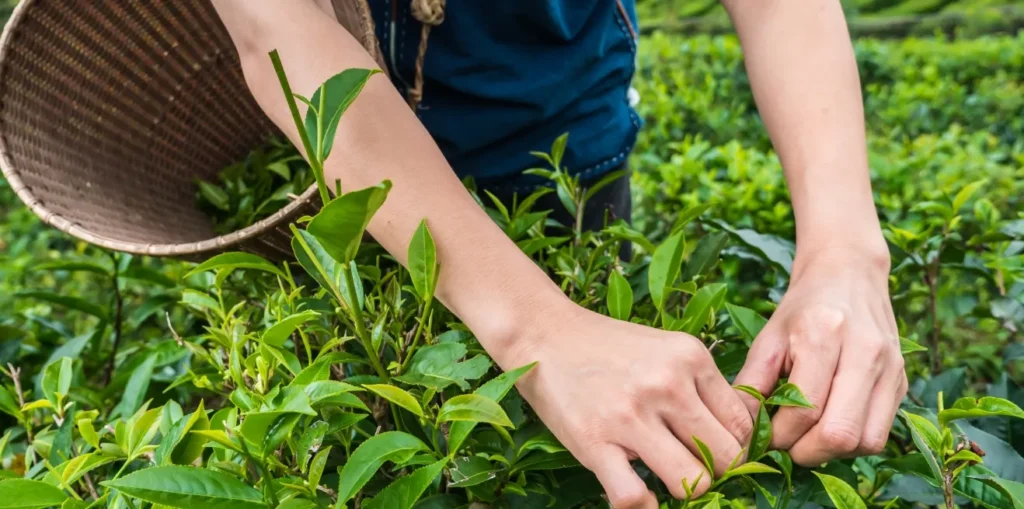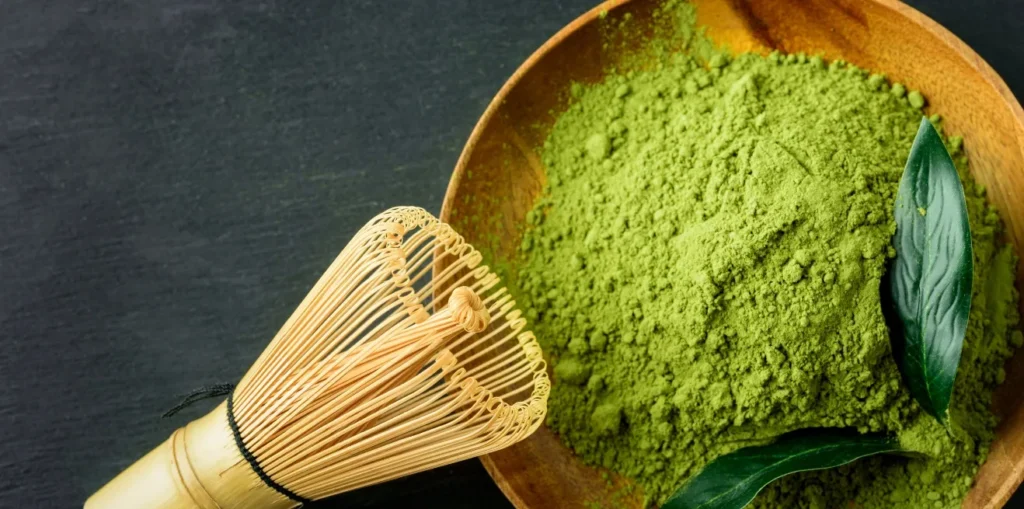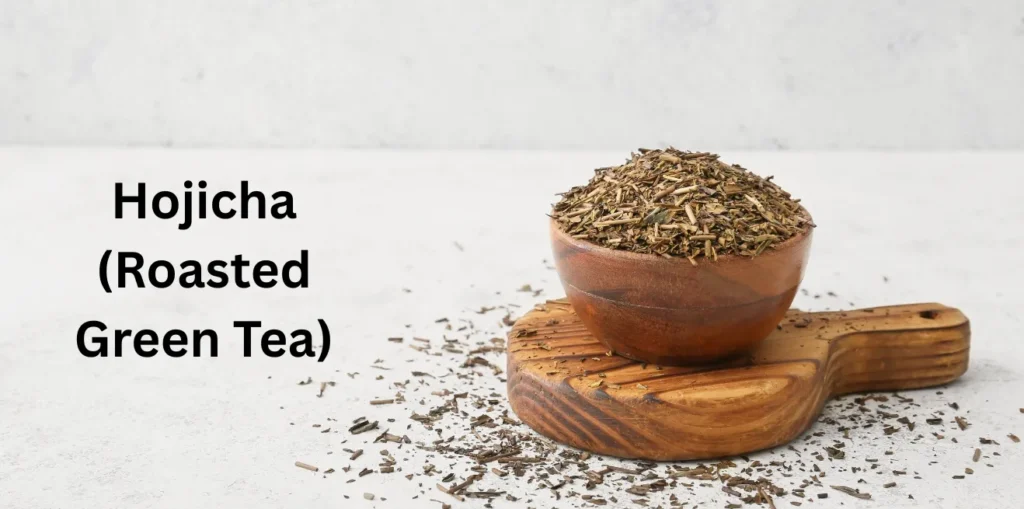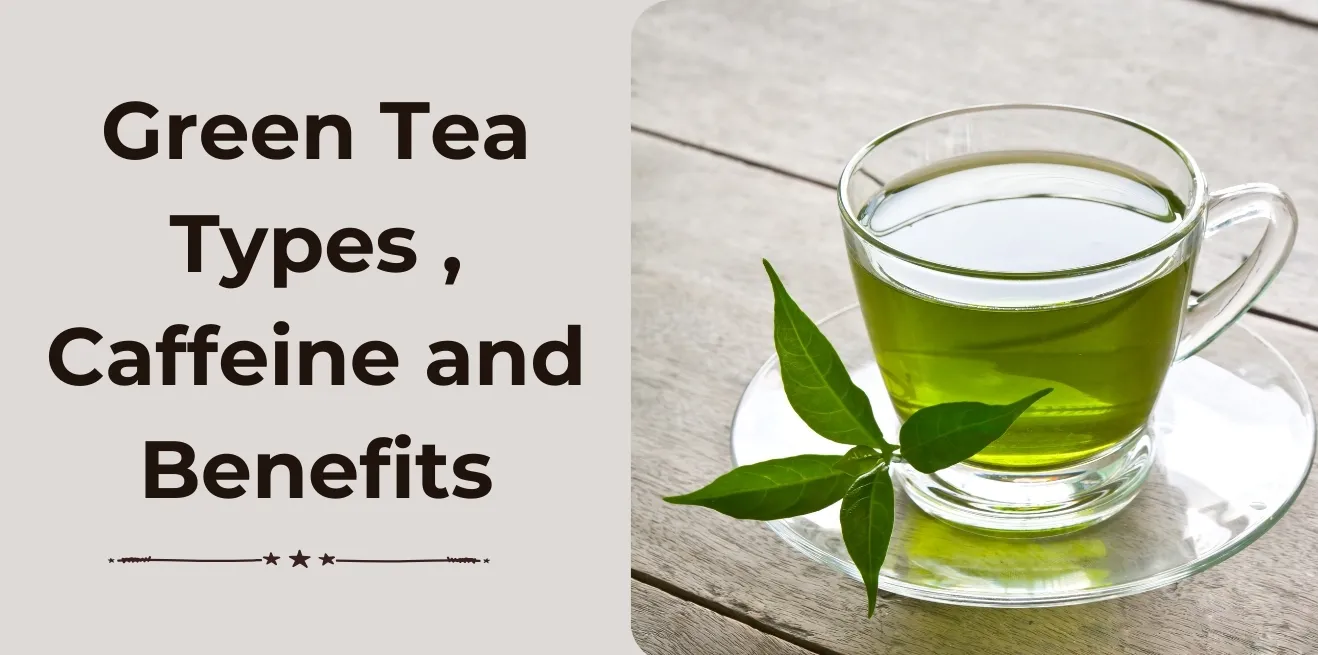What Is Green Tea?
Green tea is made from the leaves of Camellia sinensis plant. It has a long history that dates back thousands of years. Green tea originated in China, where people first discovered that brewing the leaves of the Camellia sinensis plant created a flavorful and refreshing drink. Over time, drinking green tea became a daily habit in Chinese culture, appreciated not just for its taste, but also for its calming and health-supporting properties.
Later, green tea spread to Japan, where it took on even greater cultural importance. In Japan, green tea is a central part of traditional tea ceremonies, which focus on mindfulness, respect, and simplicity. Today, green tea remains a key part of life in both China and Japan, with many different styles and traditions based around how it is grown, prepared, and enjoyed.

Although green tea, black tea, and oolong tea all come from the same Camellia sinensis plant, they are processed differently. The special thing about green tea is how it is processed with minimal oxidation. Right after the tea leaves are harvested, they are quickly heated by methods like steaming (common in Japan) or pan-firing (common in China). This step stops oxidation, which is the natural chemical change that darkens leaves and develops stronger flavors. Because green tea is barely oxidized, it keeps its bright green color, fresh grassy flavor, and lighter taste compared to black tea, which undergoes full oxidation.
This careful and minimal processing not only keeps the natural qualities of the leaves but also helps to preserve important compounds like catechins, which are powerful antioxidants found in green tea. These unique features make green tea stand out among other types of tea and contribute to its reputation as a healthy beverage.
What Makes Green Tea Special?
Green tea is different from other types of tea because of its natural compounds, smooth flavor, and long history. It is enjoyed not only as a daily drink but also for its important role in traditional health practices.
High Antioxidant Content
- One of the main reasons green tea is valued is its high amount of antioxidants.
It contains a special group of compounds called catechins, with epigallocatechin gallate (EGCG) being the most powerful and researched. - Antioxidants help protect the body’s cells from damage. They may also support healthy aging, heart function, and the immune system.
- Because of its rich antioxidant content, green tea is often considered one of the healthiest beverages you can drink.
Smooth and Fresh Flavor
- Green tea is known for its smooth and fresh flavor. Unlike black tea, which is stronger and darker, green tea tastes lighter and more delicate.
- The minimal oxidation during processing helps it keep its natural, grassy notes. Some types of green tea even offer slight sweetness or floral hints, depending on how they are grown.
- This gentle flavor makes green tea easy to enjoy daily without feeling heavy.
Caffeine and L-Theanine for Calm Focus
- Green tea naturally contains caffeine, but in smaller amounts than coffee. It also has L-theanine, an amino acid that helps create a sense of calm.
- Together, caffeine and L-theanine promote calm focus — alertness without the jittery feeling coffee often causes. This balance makes green tea a good choice for studying, working, or relaxing.
- Many people prefer it for mental clarity that feels smooth and steady.
Longstanding Use in Traditional Medicine
- For hundreds of years, green tea has been used in traditional medicine in countries like China and Japan.
- It was believed to support digestion, heart health, skin health, and overall energy levels.
Green tea was often recommended as part of daily routines to maintain balance and wellness. - Today, even as modern science studies its effects, the long history of traditional use continues to add to green tea’s strong reputation.
Types of Green Tea
There are many types of green tea, each with its own unique flavor, appearance, and method of production.
Understanding these types can help you choose the one that matches your taste and needs.
1. Sencha (Japanese Steamed Green Tea)
Sencha is the most popular type of green tea in Japan.
It is made by steaming freshly picked leaves, which stops oxidation and keeps the tea bright and flavorful.
Sencha has a fresh, slightly grassy flavor and a clear green color.
It is enjoyed both hot and cold and is often the first green tea people try when exploring Japanese teas.
2. Matcha (Powdered Japanese Green Tea)

Matcha is a special form of green tea where the leaves are ground into a fine powder.
Instead of steeping and discarding the leaves, you whisk the powder into water and drink the whole leaf.
Because you consume the entire leaf, matcha provides more antioxidants and caffeine compared to other types. It has a rich, full taste and is often used in traditional Japanese tea ceremonies and modern recipes like smoothies and desserts.
3. Gyokuro (Shade-Grown Premium Tea)
Gyokuro is a high-quality Japanese green tea known for its sweet, rich flavor.
The tea plants are covered with shade for several weeks before harvest, which increases their chlorophyll content.
This special growing method gives Gyokuro a deep green color and a smooth, almost buttery taste.
It is often considered one of the finest green teas available.
4. Dragonwell (Longjing – Chinese Pan-Fried Tea)
Dragonwell, also known as Longjing tea, is one of the most famous Chinese green teas.
The leaves are pan-fried by hand right after picking, giving them a flat shape and a slightly roasted aroma.
Dragonwell has a mild, sweet flavor with hints of chestnut. It is known for its smooth texture and beautiful green color.
5. Hojicha (Roasted Green Tea)

Hojicha is a type of Japanese green tea that is roasted at a high temperature.
This roasting process changes the color of the leaves to brown and gives the tea a warm, nutty flavor.
Because much of the caffeine is removed during roasting, Hojicha is low in caffeine. It is a good choice for drinking in the evening or for people who prefer a milder tea.
6. Bancha (Lower-Grade, Later Harvest Tea)
Bancha is made from tea leaves that are harvested later in the season, after the earlier and more delicate picks.
This gives Bancha a stronger flavor and a slightly more robust character compared to Sencha.
Bancha is often enjoyed as an everyday tea in Japan. It is affordable, easy to brew, and still provides many of the same benefits found in higher-grade green teas.
Does Green Tea Have Caffeine?
Many people ask whether green tea contains caffeine.
The simple answer is yes, but it usually has less caffeine than coffee or black tea.
This makes it a good choice for people who want a mild energy boost without feeling jittery.
- Green tea (regular brew): 25 to 45 milligrams of caffeine per 8-ounce cup
- Matcha (powdered green tea): 60 to 80 milligrams of caffeine per serving
Several factors affect how much caffeine your cup of green tea contains, including:
- The type of green tea (some varieties naturally have more caffeine)
- How the tea is processed (shade-grown teas like Gyokuro have higher caffeine)
- Brewing method (hotter water and longer steeping time extract more caffeine)
Because matcha uses the whole tea leaf ground into powder, it delivers more caffeine than regular brewed green tea. For people sensitive to caffeine, choosing lighter teas like Sencha or Bancha and using cooler water can help lower the amount they consume.
If you want a full guide on how much caffeine is in different green teas and tips to control it, visit: Does Green Tea Have Caffeine?
How Green Tea Is Made
The process of making green tea is simple but very important.
Each step helps to protect the tea’s natural flavor, color, and healthy compounds.
The basic steps to make green tea are:
- Picking: Fresh tea leaves are carefully picked by hand or machine.
- Steaming or Pan-Firing: Right after picking, the leaves are quickly heated to stop oxidation.
- In Japan, leaves are usually steamed, giving the tea a fresh, grassy taste.
- In China, leaves are often pan-fired, creating a softer, slightly roasted flavor.
- Rolling: The leaves are rolled and shaped to release their natural juices and help form their final shape.
- Drying: Finally, the leaves are dried to remove moisture and lock in flavor.
One of the key differences between Chinese and Japanese green teas is the heating method.
Japanese teas like Sencha and Matcha are steamed, while Chinese teas like Dragonwell (Longjing) are pan-fried. This small change creates very different flavors and textures.
The main goal during green tea production is to prevent too much oxidation. Minimal oxidation helps green tea keep its bright green color, fresh taste, and valuable nutrients like catechins and L-theanine.
This careful process is what makes green tea special, both as a healthy drink and a cultural tradition.
Nutritional Profile of Green Tea
Green tea is not just a refreshing drink; it is also rich in important nutrients that offer several health benefits.
Each cup of green tea provides natural compounds that support the body and mind in different ways.
- Antioxidants (EGCG): Help protect cells from damage caused by free radicals.
EGCG is also linked to weight management and supporting metabolism. - L-theanine: Promotes calm focus by encouraging relaxation without causing drowsiness.
It works together with caffeine to support mental clarity. - Caffeine: Increases alertness and helps improve short-term focus and energy levels.
The amount in green tea is enough to refresh without causing overstimulation. - Vitamin C: Supports immunity by helping the body fight off infections and maintaining healthy skin.
- Minerals (Potassium, Magnesium): Help maintain heart health by supporting normal blood pressure and muscle function.
The unique combination of these nutrients makes green tea a smart choice for daily wellness.
Drinking green tea regularly can be an easy way to add natural antioxidants, vitamins, and minerals to your diet.
Health Benefits of Green Tea
Green tea has many health benefits. Its rich supply of antioxidants, nutrients, and natural compounds makes it a powerful drink for supporting the body and mind in many ways.
1. Antioxidant Power Against Free Radicals
Green tea is packed with antioxidants, especially catechins like EGCG.
These antioxidants help protect the body from damage caused by free radicals, which are unstable molecules that can harm cells and speed up aging.
By drinking green tea regularly, you may help strengthen your body’s defense system and support long-term health.
2. Heart Health and Cholesterol Improvement
Studies suggest that green tea can support heart health by improving cholesterol levels.
It may help lower LDL (bad cholesterol) while raising HDL (good cholesterol), leading to better heart function overall.
Regular consumption of green tea is often linked with a reduced risk of heart disease and stroke.
3. Boosts Brain Function and Focus
The natural combination of caffeine and L-theanine in green tea helps improve brain function.
Together, they support faster thinking, better concentration, and a calmer mental state without causing jitteriness.
Many people choose green tea when they need clear focus for work, study, or creative activities.
4. May Help With Weight Management
Green tea is often associated with weight management.
The catechins in green tea, especially EGCG, can help support fat burning and make it easier for the body to use energy efficiently.
This makes green tea a popular addition to a healthy lifestyle focused on weight control.
5. Supports Metabolism and Fat Burning
Along with helping with weight management, green tea can boost the body’s metabolism.
A faster metabolism means the body burns more calories even when at rest.
Some research shows that green tea extracts are used in natural fat-burning supplements because of their strong effect on metabolism.
6. Potential Cancer-Protective Effects
Because of its high antioxidant content, green tea may offer some cancer-protective benefits.
Antioxidants help prevent cell damage that can lead to the development of certain types of cancer.
While more research is needed, early studies suggest green tea may help lower the risk of cancers such as breast, prostate, and colorectal cancer.
7. Promotes Dental Health and Fresh Breath
Green tea also supports dental health.
Its natural compounds can reduce the growth of bacteria in the mouth, lower the risk of cavities, and improve gum health.
Drinking green tea regularly may also help maintain fresh breath by preventing bad bacteria from causing odor.
Potential Side Effects of Green Tea
While green tea is safe for most people, it can cause mild side effects in some situations.
Being aware of these can help you enjoy green tea without discomfort.
Some possible side effects include:
- Caffeine sensitivity: Because green tea contains caffeine, some people may experience jitters, anxiety, or trouble sleeping if they drink too much.
- Digestive upset: Drinking green tea on an empty stomach can sometimes cause stomach discomfort or nausea.
It is usually better to enjoy green tea after a meal or snack. - Iron absorption issues: Green tea can slightly reduce the body’s ability to absorb iron from foods.
To avoid this, it is best to drink green tea between meals rather than during meals. - Rare allergic reactions: In very rare cases, people may experience allergic reactions to green tea, such as skin rashes or breathing problems.
Anyone who notices unusual symptoms after drinking green tea should stop using it and consult a doctor.
Green Tea vs Other Teas
Green tea is one of many types of tea, and each type has its own unique properties.
The main differences come from how much the leaves are oxidized, how much caffeine they contain, and their flavor profiles.
Here is a simple comparison:
| Tea Type | Caffeine (8 oz) | Oxidation Level | Flavor Profile |
|---|---|---|---|
| Green Tea | 25–45 mg | Minimal oxidation | Fresh, grassy |
| Black Tea | 40–70 mg | Full oxidation | Bold, robust |
| White Tea | 15–30 mg | Minimal, young leaves | Delicate, light |
| Oolong Tea | 30–50 mg | Partial oxidation | Floral, complex |
| Herbal Tea | 0 mg | Not from tea plant | Varies (depends on herbs) |
Key Differences
- Green tea is minimally oxidized, which helps it keep its fresh, light flavor and important nutrients like antioxidants.
- Black tea is fully oxidized, giving it a stronger flavor and higher caffeine content.
- White tea is the least processed and made from young leaves. It has very low caffeine and a delicate, soft taste.
- Oolong tea is partially oxidized and sits between green and black tea in both flavor and caffeine.
- Herbal tea is different because it is made from herbs, flowers, or fruits, not from the Camellia sinensis plant. Most herbal teas are naturally caffeine-free.
Choosing between these teas depends on what you are looking for — whether it is freshness, strong flavor, low caffeine, or health benefits like antioxidants.
How to Brew Green Tea the Right Way
Brewing green tea correctly helps you enjoy its full flavor, aroma, and health benefits.
Using the right water temperature, steeping time, and tools can make a big difference in the taste of your tea.
Water Temperature: 160°F–180°F (Not Boiling!)
Green tea is delicate and should be brewed with water between 160°F and 180°F.
Boiling water can burn the leaves and create a bitter taste.
If you don’t have a thermometer, simply boil the water and let it cool for about 2 minutes before pouring it over the tea leaves.
Steeping Time: 1–3 Minutes
For the best flavor, steep green tea for only 1 to 3 minutes.
Steeping it too long can release too many tannins, making the tea taste bitter and dry.
Shorter steeping brings out the tea’s natural sweetness and freshness.
Ideal Tools: Kyusu, Gaiwan, or Strainer
Using the right tools can improve your brewing experience:
- Kyusu: A traditional Japanese teapot designed for green tea, with a built-in fine strainer.
- Gaiwan: A Chinese tea bowl with a lid, perfect for controlling steeping time.
- Strainer: If you are using loose leaves, a simple fine mesh strainer can work well.
Choosing the right tool helps ensure the leaves have enough room to expand and release their full flavor.
Loose Leaf vs Tea Bags
Loose leaf green tea usually offers better flavor and quality than regular tea bags.
The leaves are larger, fresher, and less processed.
However, high-quality pyramid-style tea bags can still provide a good option for convenience while allowing the leaves to expand properly.
For a complete step-by-step guide to brewing the perfect cup, visit: How to Brew Green Tea for Best Flavor
Green Tea for Weight Loss: Fact or Hype?
Many people hear that green tea can help with weight loss. While some of the claims are supported by science, it is important to understand what green tea can and cannot do.
How EGCG Helps With Fat Oxidation
Green tea is rich in epigallocatechin gallate (EGCG), a powerful antioxidant.
Research shows that EGCG may help increase fat oxidation, which means the body can break down fat more efficiently during exercise and rest.
This makes green tea a useful addition to a healthy diet and active lifestyle, but it is not a magic solution for weight loss on its own.
Boosting Metabolism With Caffeine Synergy
Green tea also contains caffeine, which works together with EGCG to support metabolism.
This caffeine synergy can slightly raise the number of calories your body burns each day, even while at rest.
However, the boost is usually modest — helpful over time when combined with proper nutrition and physical activity.
Evidence-Based Benefits vs Unrealistic Marketing
Scientific studies suggest that drinking green tea regularly can help with weight management, but the effects are moderate. It can assist with fat burning and calorie use, but it will not cause major weight loss without other healthy habits.
Some marketing claims about green tea promoting “rapid weight loss” are exaggerated. It is important to rely on evidence-based benefits and not expect unrealistic results from drinking tea alone.
Choosing the Best Green Tea
With so many types of green tea available, picking the right one can feel overwhelming.
Knowing what to look for can help you choose a tea that matches your taste, health goals, and budget.
Organic vs Conventional Green Tea
Organic green tea is grown without the use of synthetic pesticides or fertilizers.
Choosing organic can be a good idea if you want to reduce exposure to chemical residues.
However, many conventional green teas are also safe and tested for quality.
The most important thing is to buy from trusted sources that offer transparent information about their farming and production methods.
Loose Leaf vs Bags vs Powdered (Matcha)
- Loose leaf green tea usually offers the best flavor and quality. The larger leaves hold more natural oils, giving a richer taste.
- Tea bags are convenient, but often contain smaller leaf pieces (called dust or fannings), which can produce a less complex flavor.
- Matcha is a powdered form of green tea where you consume the whole leaf. It provides a stronger flavor and higher amounts of antioxidants and caffeine.
If quality and experience matter most, loose leaf or ceremonial-grade matcha are excellent choices.
For daily convenience, high-quality pyramid tea bags can also be a good option.
Japanese vs Chinese vs Korean Green Teas
- Japanese green teas like Sencha, Gyokuro, and Matcha are steamed, giving them a bright, grassy flavor.
- Chinese green teas like Dragonwell (Longjing) are usually pan-fired, offering a smoother, slightly roasted taste.
- Korean green teas such as Jeju Island teas are growing in popularity and often combine the freshness of Japanese styles with the softness of Chinese teas.
Each region produces distinct flavors, so trying different types can help you discover your personal favorite.
Best Brands and Recommendations
When choosing a green tea brand, look for companies that focus on freshness, ethical sourcing, and clear product labeling.
Some well-known brands include:
- Ippodo Tea Co. (Japan) – Famous for high-quality matcha and Sencha.
- Yamamotoyama (Japan) – Good everyday Sencha and Genmaicha.
- Teavana (International) – Wide selection, including blends.
- Rishi Tea (USA) – Organic and direct-sourced green teas.
- O’sulloc (Korea) – High-end Korean green teas from Jeju Island.
Popular Green Tea-Based Drinks and Recipes
Green tea is not just for traditional brewing. It can be used in many refreshing and creative drinks that fit different tastes and lifestyles.
Here are some popular ways to enjoy green tea:
Iced Green Tea
Iced green tea is a simple and cooling option, perfect for warm days.
- Brew green tea at a lower temperature (around 160°F–170°F) to keep it smooth.
- Steep for 2 minutes, then chill the tea over ice.
- Add a slice of lemon or a bit of honey if you like a hint of sweetness.
Matcha Latte
A matcha latte combines the boldness of matcha powder with creamy milk for a satisfying drink.
- Whisk ceremonial-grade matcha with a small amount of hot water to form a smooth paste.
- Warm your choice of milk (dairy, almond, oat) and pour it over the matcha.
- Optional: Add a teaspoon of honey or vanilla for extra flavor.
Green Tea Smoothies
Smoothies from Green Tea are a nutritious way to start your day.
- Brew a small cup of strong green tea and let it cool.
- Blend it with frozen fruits like banana, mango, or berries.
- Add a scoop of yogurt or a spoonful of chia seeds for more texture and nutrients.
Green Tea Lemonade
Green tea lemonade is a refreshing, lightly tangy drink that’s easy to make.
- Brew green tea and allow it to cool.
- Mix the tea with fresh lemon juice and a touch of honey or agave syrup.
- Serve over ice for a crisp, energizing beverage.
Conclusion
Green tea is more than just a simple beverage. It offers gentle energy, a rich supply of antioxidants, and a wide range of health benefits that make it a smart choice for daily living.
Whether you need a focused start to your morning, a refreshing break in the afternoon, or a calming drink in the evening, green tea adapts easily to your routine. Its natural balance of caffeine and L-theanine gives you steady focus without the jitters, making it a trusted companion at any time of day.
With so many types, flavors, and easy brewing methods, green tea is both simple to prepare and enjoyable to drink. From traditional cups to modern recipes like iced green tea and matcha lattes, there is a style for everyone.
FAQs About Green Tea
Q.1 How much green tea should I drink daily?
Most experts recommend drinking 2 to 3 cups of green tea per day to enjoy its health benefits. This amount provides a good balance of antioxidants and caffeine without overwhelming the body. However, the ideal amount can vary depending on your personal health, caffeine tolerance, and lifestyle.
Q.2 Can green tea help with anxiety?
Green tea contains L-theanine, an amino acid that promotes a sense of calm and relaxation.
L-theanine helps balance the stimulating effects of caffeine, which can make green tea a better choice for people who are sensitive to caffeine-related anxiety compared to coffee.
However, those with severe anxiety should monitor their caffeine intake carefully.
Q.3 Does decaf green tea still have health benefits?
Decaf green tea still retains many of its important compounds, including antioxidants like catechins.
While the decaffeination process can slightly reduce the levels of some nutrients, decaf green tea remains a healthy choice for people who want the benefits of green tea without the caffeine.
Q.4 How is matcha different from regular green tea?
Matcha is made by grinding entire green tea leaves into a fine powder.
When you drink matcha, you consume the whole leaf, not just the brewed water.
This means matcha provides higher levels of antioxidants, caffeine, and nutrients compared to regular brewed green tea.
Q.5 Is it okay to green tea on an empty stomach?
Some people may experience stomach discomfort or nausea if they drink green tea on an empty stomach. It is often better to enjoy green tea after eating or with a small snack to avoid any digestive upset, especially with stronger varieties like matcha.



